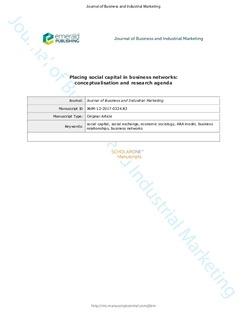| dc.contributor.author | Bondeli, Julia Vevenko | |
| dc.contributor.author | Havenvid, Malena Ingemansson | |
| dc.contributor.author | Solli-Sæther, Hans | |
| dc.date.accessioned | 2019-01-09T12:00:06Z | |
| dc.date.available | 2019-01-09T12:00:06Z | |
| dc.date.created | 2018-11-27T14:54:45Z | |
| dc.date.issued | 2018 | |
| dc.identifier.citation | The journal of business & industrial marketing. 2018, 33 (8), 1100-1113. | nb_NO |
| dc.identifier.issn | 0885-8624 | |
| dc.identifier.uri | http://hdl.handle.net/11250/2579935 | |
| dc.description.abstract | Purpose
This paper aims to refine conceptual treatment of the social facet in business relationships and reinforce its significance in the industrial marketing and purchasing (IMP) research tradition by integrating the concept of social capital in its original interpretation into the actor-resource-activity (ARA) model.
Design/methodology/approach
The paper begins by indicating some typical conceptual challenges associated with application of social capital in IMP. This is followed by a conceptual clarification that explores the origin and the essence of social capital in economic sociology. Finally, the paper proposes integrating social capital in its original interpretation into IMP’s ARA model and presents four propositions on how social capital is created in interaction between business actors.
Findings
The paper shows how bridging Bourdieu’s theory of social capital with the IMP approach may solve the identified conceptual challenges. This paper’s main contribution is a cyclical model depicting how social capital is created in business networks. It is integrated into the ARA model and designed specifically for studying the social facet of business relationships.
Research limitations/implications
The paper is expected to aid IMP researchers in empirical contexts where the social component in business relationships is particularly prominent. As such, the novel approach presented could be used to further understand how social exchange processes are related to relationship governance, relationship initiation and development.
Originality/value
The proposed model shows how social capital is generated through the dynamic interplay in the social facets of actor, activity and resource dimensions, emphasising its creation dynamics. The model integrates insights from the classic works in economic sociology to strengthen the social side of IMP’s socioeconomic interface and is intended to be used as a tool for empirical application. | nb_NO |
| dc.language.iso | eng | nb_NO |
| dc.publisher | Emerald | nb_NO |
| dc.title | Placing Social Capital in Business Networks: Conceptualisation and Research Agenda | nb_NO |
| dc.type | Journal article | nb_NO |
| dc.type | Peer reviewed | nb_NO |
| dc.description.version | acceptedVersion | nb_NO |
| dc.source.pagenumber | 1100-1113 | nb_NO |
| dc.source.volume | 33 | nb_NO |
| dc.source.journal | The journal of business & industrial marketing | nb_NO |
| dc.source.issue | 8 | nb_NO |
| dc.identifier.doi | 10.1108/JBIM-12-2017-0324 | |
| dc.identifier.cristin | 1635877 | |
| dc.description.localcode | © 2018. This is the authors' accepted and refereed manuscript to the article. The final authenticated version is available online at: https://doi.org/10.1108/JBIM-12-2017-0324 | nb_NO |
| cristin.unitcode | 194,60,15,0 | |
| cristin.unitname | Institutt for internasjonal forretningsdrift | |
| cristin.ispublished | true | |
| cristin.fulltext | postprint | |
| cristin.qualitycode | 1 | |
